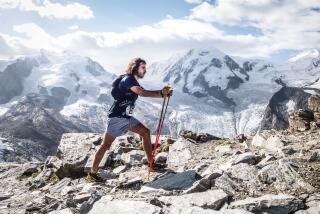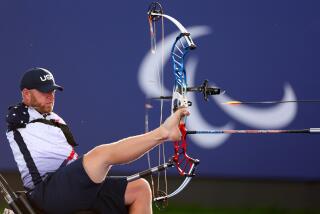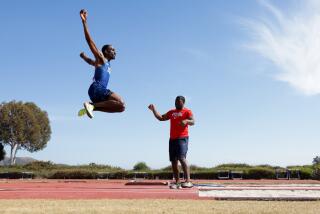An Uphill Battle : Todd Huston, whose right leg was amputated 12 years ago, has an artificial limb for everyday use, but on special occasions he uses the one that lets him move mountains--by climbing them.
- Share via
IRVINE — Todd Huston has three right legs. There’s the phantom one, the leg he still senses as being there, though it was amputated 12 years ago. “I can still tell you exactly where each of my toes is,” he says.
There is his everyday leg, with a flesh-toned exterior and cosmetic toes. And then there is his mountain-climbing leg, a bare graphite, metal and fiberglass Terminator-looking appendage with a boot’s Vibrum sole glued right to the heel. That sole is worn and crumbling at the edges, as one might expect of one used in setting a world record.
We were talking at the Sports Club, Irvine, where Huston trains. Earlier this year Huston, 33, scaled the highest point in each of the 50 states in 66 days, beating the previous record of 101 days set by an able-bodied man in 1990.
Some of those summits were downright comical, such as Britton Hill, which at 345 feet above sea level is the highest spot in Florida. Then there’s Delaware’s dimple of a peak, Ebright Azimuth, “which happened to be in the middle of a street, right outside of Wilmington,” Huston said. “But it took us several tries to get a picture there because there was so much traffic.”
At the other extreme was Alaska’s Mt. McKinley, the highest point in North America and 20,320 feet of mean. Huston was climbing in minus-35 degree weather there, while Texas’ Guadalupe Peak was scaled in 118-degree heat. On other heights, he was beset by biting black flies or high winds. Just getting from climb to climb was an effort, often driving 500 miles a day, and sometimes rerouting to dodge tornadoes.
It’s a trek that few complete, only 37 including Huston to date. He is the first one-legged man to attempt it. Rather than dwell on the hardships his unique status imposed, he prefers to joke about the advantages.
“I only had five toes to worry about getting frostbit. I only had to worry about one ankle twisting. My right calf muscle never got sore. So I had a leg up on other climbers. Did I ever feel de-feeted? No,” he said.
Huston, a Balboa Island resident, is a psychotherapist who is clinical director of the Amputee Resource Center at Brea’s NovaCare Orthotics and Prosthetics, helping amputees to deal with the trauma of limb loss.
Huston’s own trauma began at age 14 when he was water skiing with his family in Oklahoma. He had been in the water untangling the ski rope when the family’s boat slipped into reverse.
“I was yelling ‘Stop the engine,’ but no one could hear me, and I had one of these big heavy water skiing jackets on and couldn’t swim, so the boat hit me, and it sucked both my legs into the propeller,” he recalled. “When they pulled me out of the water there was blood squirting six to eight feet out of my body. My left leg was completely open and the whole backside was missing from my right leg.”
A nerve had been severed in his right leg, paralyzing it. Doctors told his family he probably wouldn’t walk again. A month and a half later he was barely able to walk out of the hospital “on legs like spaghetti noodles.”
By the time he was in college the reduced circulation in his paralyzed leg caused it to become infected, resulting in lengthy hospitalizations that often kept him from attending classes or working.
“After a whole series of operations, that eventually led to the decision to just amputate the leg. So at age 21 I chose to have my leg amputated, because what I wanted was to have a life and a lifestyle over a leg.
“It’s a very tough decision, because it’s permanent. You can’t do it and go, ‘Oops, wrong decision, let’s go back.’ I knew I’d have to live with it for the rest of my life.
“When they did it I was wide-awake on the operating table, with not even an aspirin in me, for two reasons. One: I wanted to feel I had more control over the situation than my disease did, and two: If you’re anesthetized, after surgery you can’t eat pizza. And I love to eat pizza after surgery. So after I had my leg amputated I went back to my room and ate pizza.”
*
Huston wore a conventional prosthetic leg for a decade, which permitted him to live a productive life, though not a physically active one. “I could not take more than four or five running steps without tremendous pain and couldn’t walk over half a mile at any one time. At night I’d have these vivid dreams about running in a field.”
After breaking a couple of conventional legs with his exertions, two years ago he got his insurance company to spring for a new leg, called a Flex-Foot manufactured in Aliso Viejo. Its design, which includes a shock absorber and spring-like flexible graphite, responded more like a real limb.
“Initially I could only run about 100 feet with it, I was so out of shape. I called everybody I knew the day I was finally able to run all the way around Balboa Island. After three months I was able to run all the way to Laguna and beyond.”
He had been working in computer software design when he got the leg. A difficult divorce and other problems at the time prompted him to do some soul-searching, he said. He determined he wanted to work helping other amputees and found the position with NovaCare.
There, he was approached by an organization to help find a leg amputee to be part of an expedition of disabled people intending to climb the 50 peaks. “And I thought, ‘Hey, I’m interested in that,’ and applied and was accepted,” he said.
*
He began training for the climb, spending weekends on the rocks at Joshua Tree or on local mountain trails. “I had to become acclimatized, since on Balboa I’m breathing the same air sharks do,” he said.
He did most of his training at the Sports Club, where they have a rotating rock wall that he could climb on without a break. “It’s more like the real thing. When you’re on a mountain you can’t just step off it like you do a Stair Climber and say you’re done for the day,” he said.
A month shy of the start date the expedition fell through due to lack of funding, and Huston was determined to do the trek, now titled Summit America, himself, climbing with only the original expedition’s guide, 27-year-old Whit Rambach of Fresno.
He estimates his expenses for the trip at $60,000. Huston got help from both his employer (for which he now works on a contract basis) and Flex-Foot, as well as the North Face outfitters. His friend and publicist Lisa Manley was selling T-shirts to promote the climb one weekend on Balboa when a jogger, who turned out to be Hooked On Phonics CEO John Shanahan, took an interest and became the expedition’s principal sponsor.
Initially this spring Huston and Rambach took on 33 eastern states, which generally were easier than the western climbs. The harsh winter, however, caused some of the northeast slopes to be closed, so they headed to Alaska’s Mt. McKinley. They reached its summit June 1, and there Huston decided to start the clock all over again.
His toes were so battered by the climb he didn’t think he could face the tough western mountains immediately. Also by starting over with McKinley as the first peak, the days they had spent in the ascent weren’t counted (since the record is determined by the time between the first peak and the last).
So they headed east, did 33 states all over again (twice knocking off five states in a day), took on the Northeast and then headed west, concluding on top of Hawaii’s Mauna Kea on Aug. 7.
*
Huston speaks of his journey in a positive manner but does admit there were dark moments.
“There were times when I was hiking when it felt like there were 1,000 needles pushing in the bottom of my stump every time I took a step. Sometimes I walked in that condition for eight or 10 hours. Other times my left leg would be cramping up because it had to do so much of the work.
“There were absolutely times when I felt like giving up. On Mt. Katahdin in Maine I was stung so bad by black flies my ears were just bleeding welts. The western mountains were so much more difficult than the eastern ones, more than I could have planned on. In Texas we were hiking in 118-degree heat, so we had to do some of the climbing by moonlight when it got down to a nice 92 degrees.
“On McKinley there is one point near the top where a lot of people turn around, because you’re just physically and emotionally exhausted. But I always knew that I had to keep going because if I didn’t make one mountain, I couldn’t break the record.
“And as I climbed, I became more determined because it became really important to me to get a message out, that by having faith in God and in the abilities he’s given you, you can overcome whatever challenges you have in life.”
He said he was so caught up in making his trek, literally one step at a time, that he hadn’t considered where it might lead. At the prodding of others, he says, he now has co-written a book, titled “More Than Mountains,” on his experience and is embarking on a career as a motivational speaker.
Though it’s a profession some view with suspicion, Huston said, “If it can inspire others, why not?” He mentioned he had a part as an extra in “Forrest Gump” (Huston can be spotted in a wheelchair in an Army hospital) and said that if fiction can move people, why not real life?
He said, “To go from being told I might never walk again to breaking a world record in a very physical sport that was held by an able-bodied person, maybe there’s something to be shared from what I’ve learned.”
*
He says it took a long time to arrive at his present level of assurance.
“When I was in school I can remember one guy calling me ‘the crip with the harelip.’ So I picked him up and pinned him against the locker and had a little talk with him. But usually it wasn’t the other kids. I think I beat myself up over my disability more than other people did.
“Say you’re going out with somebody and you break up. You might think it’s because of the disability, which it wasn’t: People in high school break up all the time. That’s life. But some of the things that happen naturally in life you blame on your leg.
“Losing a limb is like losing a spouse. I went through the stages of grief and loss just like anybody else should. You should feel some loss, some anger, some depression. It’s healthy to go through the pain. But it’s not healthy to stay in it too long and not work through it. You can’t sit around blaming other people. Even if they are to blame, it’s your responsibility to make the most of the situation. And through having faith in that you can get on top of your mountain.”
More to Read
Sign up for The Wild
We’ll help you find the best places to hike, bike and run, as well as the perfect silent spots for meditation and yoga.
You may occasionally receive promotional content from the Los Angeles Times.






